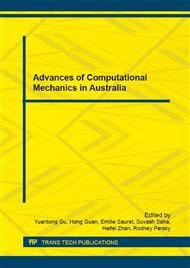[1]
X. Li, O. Zienkiewicz, Multiphase flow in deforming porous media and finite element solutions. Computers & structures. 45(2) (1992) 211-227.
DOI: 10.1016/0045-7949(92)90405-o
Google Scholar
[2]
O. Zienkiewicz, A. Chan, M. Pastor, D. Paul, T. Shiomi, Static and dynamic behaviour of soils: a rational approach to quantitative solutions. I. Fully saturated problems. Proceedings of the Royal Society of London. A. Mathematical and Physical Sciences. 429(1877) (1990).
DOI: 10.1098/rspa.1990.0061
Google Scholar
[3]
D. Sheng, S. W. Sloan, A. Gens, D. W. Smith, Finite element formulation and algorithms for unsaturated soils. Part I: Theory. International journal for numerical and analytical methods in geomechanics. 27(9) (2003) 745-765.
DOI: 10.1002/nag.295
Google Scholar
[4]
D. Sheng, D. G. Fredlund, A. Gens, A new modelling approach for unsaturated soils using independent stress variables. Canadian Geotechnical Journal. 45(4) (2008) 511-534.
DOI: 10.1139/t07-112
Google Scholar
[5]
X. Li, H. Thomas, Y. Fan, Finite element method and constitutive modelling and computation for unsaturated soils. Computer methods in applied mechanics and engineering. 169(1) (1999) 135-159.
DOI: 10.1016/s0045-7825(98)00181-9
Google Scholar
[6]
W. Ehlers, T. Graf, M. Ammann, Deformation and localization analysis of partially saturated soil. Computer methods in applied mechanics and engineering. 193(27) (2004) 2885-2910.
DOI: 10.1016/j.cma.2003.09.026
Google Scholar
[7]
A. Liakopoulos, Transient flow through unsaturated porous media. D. Eng. Berkeley, University of California at Berkeley. Doctor of Philosophy.
Google Scholar
[8]
A. Khoei, T. Mohammadnejad, Numerical modeling of multiphase fluid flow in deforming porous media: A comparison between two-and three-phase models for seismic analysis of earth and rockfill dams. Computers and Geotechnics. 38(2) (2011) 142-166.
DOI: 10.1016/j.compgeo.2010.10.010
Google Scholar
[9]
J. Ghorbani, M. Nazem, J. P. Carter, Application of the generalised-α method in dynamic analysis of partially saturated media. Computer Methods and Recent Advances in Geomechanics - Proceedings of the 14th Int. Conference of International Association for Computer Methods and Recent Advances in Geomechanics (2015).
DOI: 10.1201/b17435-19
Google Scholar
[10]
J. Ghorbani, M. Nazem, J. P. Carter, Numerical Study of Dynamic Soil Compaction at Different Degrees of Saturation. The Twenty-fifth International Offshore and Polar Engineering Conference, International Society of Offshore and Polar Engineers (2015).
Google Scholar
[11]
G. Houlsby, The work input to an unsaturated granular material. Géotechnique. 47(1) (1997) 193-196.
DOI: 10.1680/geot.1997.47.1.193
Google Scholar
[12]
N. Khalili, M. Habte, S. Zargarbashi, A fully coupled flow deformation model for cyclic analysis of unsaturated soils including hydraulic and mechanical hystereses. Computers and Geotechnics. 35(6) (2008) 872-889.
DOI: 10.1016/j.compgeo.2008.08.003
Google Scholar
[13]
S. W. Sloan, A. J. Abbo, D. Sheng, Refined explicit integration of elastoplastic models with automatic error control. Engineering Computations. 18(1/2) (2001) 121-194.
DOI: 10.1108/02644400110365842
Google Scholar
[14]
J. Lysmer, R. L. Kuhlemeyer, Finite dynamic model for infinite media. Journal of the Engineering Mechanics Division. 95(4) (1969) 859-878.
DOI: 10.1061/jmcea3.0001144
Google Scholar
[15]
B. Albers, Analysis of the propagation of sound waves in partially saturated soils by means of a macroscopic linear poroelastic model. Transport in porous media. 80(1) (2009) 173-192.
DOI: 10.1007/s11242-009-9360-y
Google Scholar
[16]
R. H. Brooks, A. T. Corey, Hydraulic Properties of Porous Media. Hydrology Papers. 3. (1964).
Google Scholar


